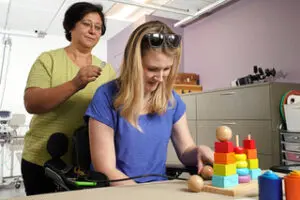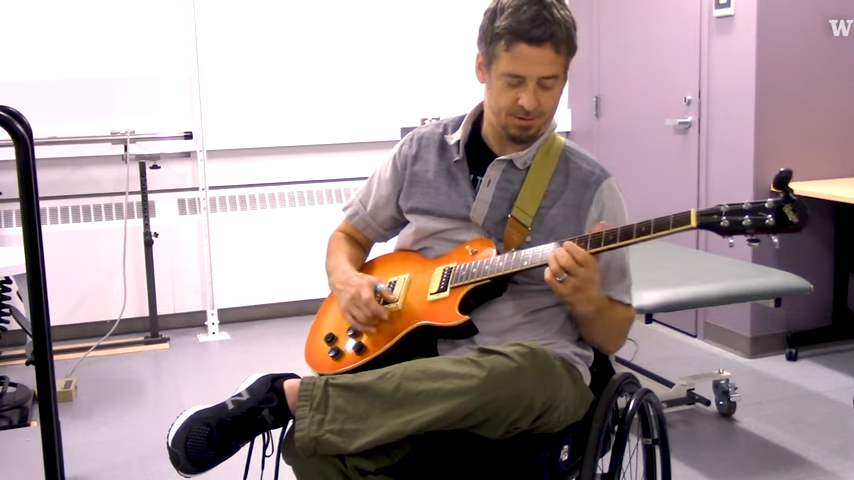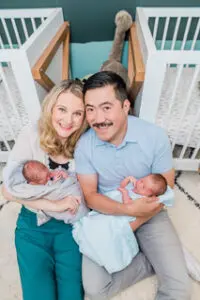Unlocking the potential for recovery
Moritz has been interested in using electrical stimulation to treat spinal cord injury since 2004, when he was a postdoctoral fellow at the University of Washington. The earliest studies involved placing wires inside the spinal cord for electrical stimulation, and although it worked, the procedure was invasive.
Then Moritz talked to a colleague who was using skin surface electrodes to stimulate the spinal cord noninvasively. By using a special high-frequency waveform, they could send more electricity through the skin, penetrating all the way to the spinal cord. It was the beginning of Moritz’s work in transcutaneous stimulation.
“For decades, we had thought that if you were paralyzed through a spinal cord injury or had persistent weakness, that’s how you were going to be for the rest of your life,” says Moritz. “But what we’re seeing now is that even with fairly simple spinal stimulation through the skin, we’re unlocking this potential for recovery.”
Jessie’s story
The most exciting part of the transcutaneous stimulation study, says Moritz, is that the participants have maintained their gains in function and hand dexterity for months — or even years — after the study ended.
One of those participants is Jessie Owen. At 27, she was in a devastating car accident that left her with a severe spinal cord injury. Diagnosed with central spinal cord syndrome, Owen lost much of the function in her limbs, particularly in her hands and arms.

Fatma Inanici, MD, PhD, a postdoctoral fellow in the Moritz lab, preparing to apply electrodes for electrical spinal stimulation to study participant Jessie Owen.
While recovering, she had to take a leave of absence from her job as an elementary school teacher and was no longer able to live independently. Owen continued exercise therapy, but says her recovery plateaued for about two years. She could walk for short periods using crutches, but still needed her wheelchair most of the time. Then, she learned about a clinical study that Moritz’s team was conducting — and she wanted to help.
“When you sustain such a devastating diagnosis, you get deep into it, and you learn a lot about it,” says Owen. “I believe that if we want to see change, then we need to be a part of it.”
During the study, Owen received spinal stimulation while practicing tasks like tying shoelaces and stringing beads. At first, she says, it was frustrating to be reminded of what she couldn’t do, but over time, the work paid off.
“For the first two months, it was immensely difficult,” Owen says. “Even after they put the stim on, I didn’t have an immediate light switch. But all of a sudden, I realized that when the stim was on, I was actually getting better. My mood was improved, I was having fun with the activities. As that last month continued, I realized that even when the stim was off, my fine motor skills were still improving and things were less challenging for me. That was a huge surprise — and a very welcome one.”

One of Jessie Owen’s paintings. Jessie was able to take up painting thanks to the increased movement she gained during the study.
By the end of the study, she had taken up painting.
Over time, the results continued to exceed expectations. Owen went from living with a friend to buying her own house, living independently and needing half as much caregiving. Even though she hasn’t received any additional electrical stimulation in the two years since the study ended, she estimates she’s retained about 90% of the gains.
“I can cook now,” says Owen. “I can tie my shoes. I can take pictures on my phone. I started a journal, and I write a few sentences in it every day.”
Today, Owen works with her local government on accessibility issues. She joined her city council’s Diversity, Equity, Inclusion and Accessibility Commission and partners with city officials to improve accessibility at public events.
But for Owen, the best achievement of all is being able to care for her twin babies. “I can get them out of their crib, I can chop up food to eat. I can take care of them,” she says.
“There are lots of physical challenges to overcome, but having these kids has continued to show me that anything is possible.”
Donor support can revolutionize lives
Soon, transcutaneous stimulation may be available to more people with spinal cord injury.
In 2022, Moritz was one of two principal investigators for a large clinical trial of a wearable external stimulator like the one Owen used. The trial, involving 65 patients, was a success, and ONWARD, the medical technology company behind the trial, will soon seek approval from the Food and Drug Administration. The company aims to launch its ARC Therapy device in late 2023. (Moritz is a consultant for ONWARD.)

Today, study participant Jessie Owen says she’s retained much of the gains from the electrical stimulation study and can even help care for her two babies.
Moritz says the stimulation device will be about the size of an iPad, but thicker. Initially, it will be available to physical therapists in a rehabilitation setting, where it can be combined with physical and occupational therapy. Eventually, the device may even be available for patients to use at home.
Meanwhile, researchers at the Moritz lab are working on other equally exciting projects. One study, made possible by donor support, combines spinal stimulation with an exoskeleton that could help people learn to walk again. Other studies are using electrical stimulation to help children with cerebral palsy improve balance and limb coordination, or to help rewire neurons in the brains of people who have had a stroke.
Thanks to donors, the lab recently added a much-needed researcher, but ongoing support is still critical to move the work forward. “Donor support is critical to launching or accelerating research — it can allow labs to focus on a new condition that they might not otherwise have bandwidth or funding to take up,” says Moritz.
For patients like Owen, that research can be life-changing.
“This work has the potential to revolutionize lives,” says Owen. “By supporting the research, you can become part of a community that is dedicated to making a real difference in the lives of people with disabilities.”
By Stephanie Perry




